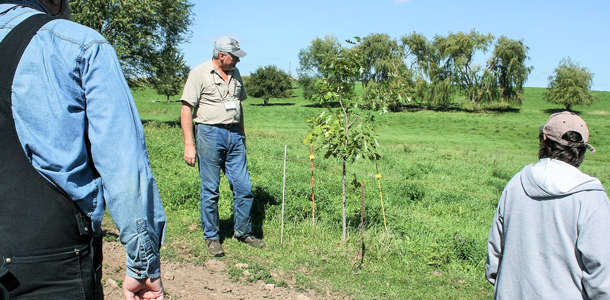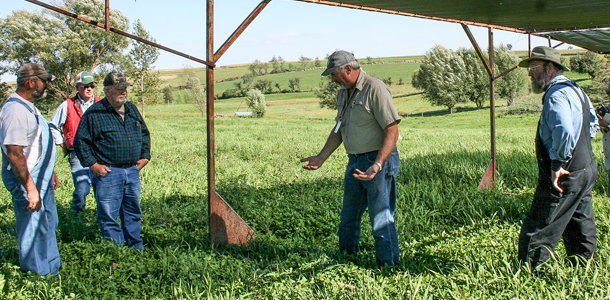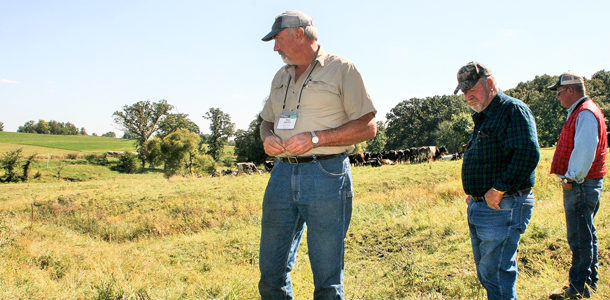Don Austin is a grazier who is not afraid to try new things. Austin, who farms near Platteville, Wisconsin, enjoys experimenting to find out what works best on his farm.
He hosted a pasture walk through Great River Graziers last fall to share some of his experiences.
He milks 80 cows in a swing-10 parlor on his 200-acre organic farm. “I get bored if I don’t experiment once in a while. That’s half the fun of farming,” Austin says.
His herd consists mostly of New Zealand Friesians crossed with shorthorns, Jerseys and other breeds. Austin used to have registered cattle and pushed for high production – but started crossbreeding in 1990.
Austin says tracking his forages and herd closely helped him realize how inexpensively he could feed his cows. He calculates what the cows need to eat on pasture with a 15-percent dry matter calculation, just like with baled hay.
He soon realized Holsteins were not breed best to utilize the high-quality, cheap forages.
Instead of breeding his cows for high production like many dairy farmers, one of the main traits he breeds for is “disposition.” Fortunately, New Zealand bulls are rated for workability.
“Obviously, in some situations disposition is more important than others. I think it is more important on a grazing farm,” he says. “It only takes one (difficult cow) to spoil your day.”
He also looks for bulls with at least 85 percent reliability, and he considers their ability to graze and reproduce.
The farm is laid out as a rectangle, with the farmstead located a mile from the far end of his farm. He says having the cows travel so far is one of the biggest issues on his farm.
The entire farm is planted in forages, and he purchases about 4,000 bushels of corn each year.
Hilly terrain, along with his decision to not invest large sums in machinery, eliminates the option of machine harvesting.
In the spring of 2014, Austin planted 7 acres of sudangrass. He grazed his 80 cows three times the following summer, with the cows consuming about 2 acres a day.
In other years, when the weather is more favorable, he has been able to graze the sudangrass four times.
Sudangrass stops being productive as soon as the cool weather starts in the Upper Midwest, so on Sept. 4, 2014, he plowed up the field and sowed a blend of oats and winter wheat for a cover crop, along with alfalfa, red clover, birdsfoot trefoil and several grasses.
Although some experts don’t recommend sorghum and sudangrass because there are better ways to get tonnage off of the land, Austin felt it worked very well for his main goal of smothering weeds.
The south-facing pasture that had been planted in corn for more than 20 years was being overtaken by pigweed and lambsquarter.
One caution for farmers grazing sudangrass is the possibility of prussic acid poisoning in cattle. Although there is some concern about acid forming when the sudangrass is under stress, the real concerns are grazing during severe drought and after the first killing frost.
Adding brassica and rye when sowing sudangrass can work well. Austin once tried the warm-season annual teff mixed with sudangrass but found the cows just weren’t very interested in it.
He tried planting Japanese millet and pearl millet in drought years but found it doesn’t yield any better than a good stand of alfalfa and clover unless it’s an extremely dry year.
Austin has tried seeding many different plants, and with his trials he has found legumes generally do better. He thinks more graziers could benefit from growing more legumes.
His pasture-watering system for his cows consists of an old milk bulk tank near the barn which fills from a hydrant. The water then gravity-feeds the tanks in the pastures, and this prevents blow-outs on the hoses from too much pressure.
 While many graziers remove trees, Austin plants them. He plants some trees every year and allows some trees to grow up on fence lines for shade, shelter and wildlife.
While many graziers remove trees, Austin plants them. He plants some trees every year and allows some trees to grow up on fence lines for shade, shelter and wildlife.
Although having just one or a few trees in a pasture can cause problems with cows congregating under them on hot days, Austin abides by the idea that many trees can serve as windbreaks and provide shade without causing problems.
He has been planting oaks along his lanes, and he incorporates the electric fence into the setup to protect the young saplings from the cows.
A few years ago, Austin traveled to the Dakotas and saw metal-framed windbreaks in fields. Although he has woods on his land, he thought windbreaks would be useful on his farm, so he built himself a couple, using corrugated metal on the frame to form a solid surface.
The cows used the man-made windbreaks in the winter, but last summer a small tornado sent it airborne. This led to a discussion at the pasture walk about what could be done to alter the design to allow some wind to blow through while still sheltering the cows.
 Austin also designed and built movable shades, 43-by-16-foot shaded roofs, for his cows to get out of the sun on hot days. Two of them are enough for his 80 cows.
Austin also designed and built movable shades, 43-by-16-foot shaded roofs, for his cows to get out of the sun on hot days. Two of them are enough for his 80 cows.
He says he likes designing and building things like this in the winter when there is not so much to do.
Austin dries up his milking herd about the first of January and has been a seasonal milker since 1994. He winters his herd outdoors feeding them round bales, offering salt and providing water from the creek. FG
Kelli Kaderly-Boylen is a freelancer based in northeast Iowa.
PHOTOS
PHOTO 1: Don Austin shares grazing experiences with fellow graziers during pasture walks.
PHOTO 2: Austin demonstrates strategic tree planting for shade and windbreaks.
PHOTO 3: Austin demonstrates movable shade structures to facilitate grazing distribution and provide windbreaks. Photos courtesy of Kelli Kaderly-Boylen.










